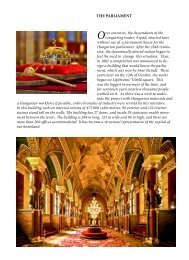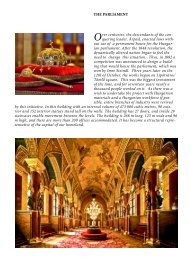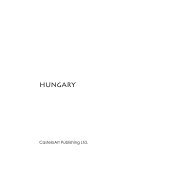Create successful ePaper yourself
Turn your PDF publications into a flip-book with our unique Google optimized e-Paper software.
SÜMEG<br />
The town of Sümeg, situated north of the mountains of<br />
Keszthely, offers numerous sights to those fond of architecture<br />
of past times. The Baroque mansion built in the 1700’s, was<br />
the birth-house and memorial building of Sándor Kisfaludy.<br />
It can be found here as well as the Bishop’s Palace and the<br />
Roman Catholic Parish Church featuring wonderful frescos,<br />
which were also built in Baroque style. The exhibition of saddle<br />
and harness history also presents the visitor with unique<br />
experiences. For many, the most interesting sight is the castle<br />
ornamenting the hilltop, well visible from quite a distance; the<br />
bishop of Veszprém had it built in the mid 13th century. When<br />
the town fell to the Turks, the castle became a bishop’s seat<br />
and it kept this position for 200 years. Because it was served as<br />
an impregnable Kuruc base for a long time, the Austrians burnt<br />
it down in a field-exercise in 1713, presumably out of revenge.<br />
SÜMEG<br />
Die Stadt Sümeg, die nördlich des Keszthelyer Gebirges liegt,<br />
birgt zahlreiche architektonische Sehenswürdigkeiten.<br />
Hier befinden sich die im 18. Jahrhundert errichtete<br />
barocke Kurie, das Geburts- und Gedenkhaus von Sándor<br />
Kisfaludy, das Bischofspalais und die römisch-katholische<br />
Gemeindekirche mit wunderschönen Fresken, die ebenfalls<br />
im Barockstil errichtet wurde. Ein einzigartiges Erlebnis<br />
bietet auch die Ausstellung mit Zaumzeug und Sätteln.<br />
Die interessanteste Sehenswürdigkeit ist die Burg auf dem<br />
Burgberg, die der Veszprémer Bischof im 18. Jahrhundert<br />
errichten ließ. Als das Gebiet in türkische Hände fiel, wurde<br />
die Stadt Bischofssitz und hielt diese Position 200 Jahre lang.<br />
Da sie lange ein uneinnehmbarer Stützpunkt der Kurutzen<br />
war, wurde sie von den Österreichern 1713 während eines<br />
Manövers, vermutlich aus Rache, in Brand gesetzt.












